COUPON – Save 30% off your entire order with code NAPLAB.

Best For
- Outstanding pressure relief with 6″ comfort layer and 12″ overall thickness
- Good edge support
- Extremely fast response time
Considerations
- 37% more expensive than the average all foam mattress
- Low levels of bounce may not be right for all sleepers
- $85 fee for returns
Our Verdict
The Polysleep Zephyr mattress is a 12″ foam mattress that uses a zoned foam design to provide optimal pressure relief and support where you need it most.
It has moderate sinkage and low bounce with a similar feel to other high-performance memory foams.
It comes in a single firmness of a medium 5 out of 10, where 10 is the most firm. This firmness level makes it a good fit for all body weights and sleeping positions.
The Polysleep Zephyr earned an overall score of 8.78 in our tests, placing it in the top 38% of all mattresses we’ve tested to date. Compared to other foam mattresses, it is in the top 32%.
Performance aside, what really hurts the Zephyr is the price tag of $2,545, as it costs over 125% more than the average foam mattress. If you’re specifically looking for a mattress made in Canada, options are more limited, and this could be a viable option.
Type: Foam
Firmness: Medium (5)
Best For: All Sleeping Positions, All Body Weights
In This Review
Performance Tests | Firmness | Support & Sleeping Positions | Design | Materials | Comparisons | FAQs
Performance Tests
At NapLab, we put each mattress to the test.
We test 10 different factors that impact the performance, comfort, and value of the mattress. We then take the results of that test and compare to every mattress we’ve tested to date.
Check out the full performance table below to see how this mattress ranks:
| Factor | Polysleep Zephyr | Average |
|---|---|---|
| Overall Score | 8.78 | 8.55 |
| Price (Queen) | C$2,545 | $1,133 (Foam only) |
| Cooling – Score | 8.0 | 8.7 |
| Sinkage – Depth | 2.06″ | 2.15″ |
| Sinkage – Feel | Moderate | Moderate |
| Motion Transfer – Score | 8.8 | 8.2 |
| Motion Transfer – Acceleration | 7.59 m/s² | 8.80 m/s² |
| Response Time – Score | 10 | 8.9 |
| Response Time – Mostly Recovered | 0.2 sec. | 0.4 sec. |
| Response Time – Fully Recovered | 0.3 sec. | 0.9 sec. |
| Bounce – Height | 6.17″ | 9.50″ |
| Bounce – Feel | Low | Moderate |
| Edge Support – Score | 8.9 | 8.6 |
| Edge Support – Sitting | 4.00″ | 4.05″ |
| Edge Support – Lying | Excellent | Good |
| Sex – Score | 7.3 | 8.4 |
| Pressure Relief – Score | 10 | 8.7 |
| Comfort Layer Thickness | 6.0″ | 4.1″ |
| Mattress Thickness | 12″ | 12.0″ |
| Off-Gassing – Score | 9.2 | 8.2 |
| Off-Gassing – Smell | Strong | Strong |
| Off-Gassing – Days | 3 days | 6 days |
| Company – Score | 7.8 | 8.8 |
| Trial | 100 nights | 176 nights |
| Warranty | 10 years | 25% have lifetime warranties, average of other 75% of mattresses is 13 years |
How is the Polysleep Zephyr Different?
The Polysleep Zephyr has a slightly higher performance score than the average, but is also quite a bit more expensive as well, costing 85% more than the average foam mattress.
Advantages
Looking strictly at performance factors, the Zephyr has lower levels of motion transfer than average, as well as a faster material response time. Edge support is better than average, only measuring 4.0″ when seated.
Neutral Factors
Considering preferential factors, the Zephyr has slightly less sinkage than average, as well as 35% less bounce than average.
Disadvantages
Cooling is a bit worse than average levels. In addition, sex performance is also below average.
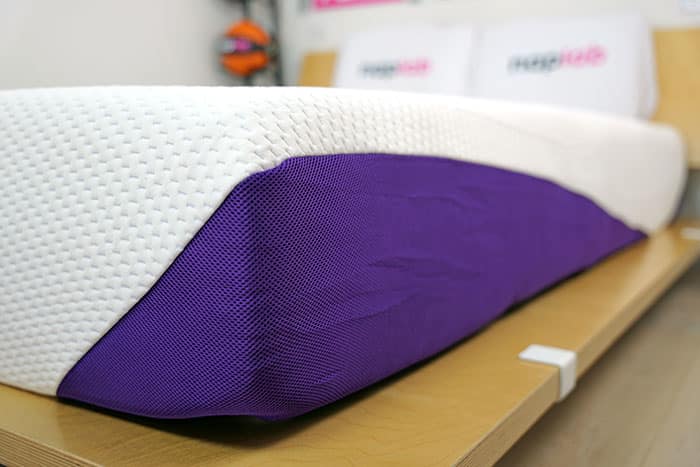
Cooling Test
Cooling performance on the Polysleep Zephyr was good, but far from great. In our test, I felt a slight to moderate level of heat retention around my body.
Baseline Temp.
82.2° F
Max Temp.
92.1° F
Ending Temp.
86.9° F
While the mattress does contain more advanced cooling foam compared to Polysleep’s less expensive Aura and Origin models, the level of cooling performance was extremely similar to what we subjectively experienced and objectively measured in our tests of the Aura.
Max Temp.

Ending Temp

- Baseline Temperature – the temperature of the mattress before anyone lies on it
- Maximum Temperature (0 minute) – the temperature of the mattress after lying on it for 15 minutes
- Ending Temperature (5 minute) – the temperature of the mattress after being lied upon and having no one on it for 5 minutes
In our objective testing data, we recorded a temperature reduction of 3.2° from minutes 0 to 1, which is 1.5° warmer than average.
The reduction from minutes 0 to 5 was 5.2°, which is 2.5° warmer than average.
Heat Dissipation Over Time
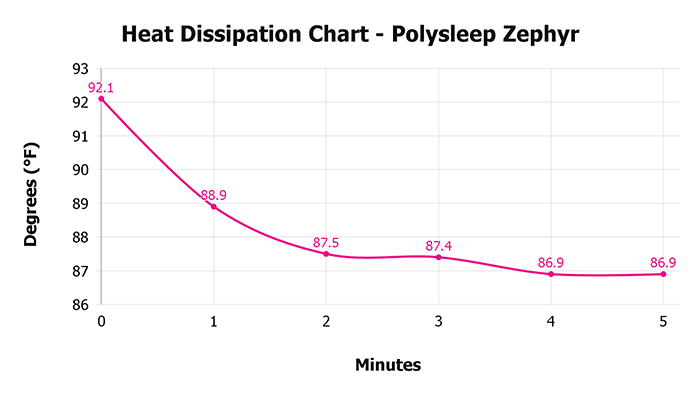
Based on an assessment of the materials, our subjective experience, and the objective data, we found the cooling performance to be somewhat lacking. Those who are more temperature sensitive will likely not be satisfied by the level of cooling performance.
Sinkage Test
The Polysleep Zephyr has a moderate level of sinkage. In our tests, we measured a pressure point sinkage depth of 2.06”. This is 0.09” less sinkage than the average of 2.15”.
Sinkage Depth
2.06″
Sinkage Feel
Moderate
Body Contour
Dramatic
The Zephyr creates a dramatic and exacting body-contouring hug. The feel is similar to other high-performance modern memory foams we’ve tested.
The level of sinkage is documented in the image below.

The Zephyr was easy to move around on and avoided any type of a stuck feeling. Lastly, pressure relief was exceptionally good. The Zephyr is incredibly comfortable to lie.
Motion Transfer Test
The Polysleep Zephyr has a low level of motion transfer. In our tests, we measured a total acceleration range of 7.59 m/s².
Accel. Range
7.59 m/s²
Motion Duration
0.49 seconds
This is 1.21 m/s² less motion than the average of 8.80 m/s². The all-foam design does a great job of quickly absorbing and dissipating energy.
The level of motion transfer is also documented in the video below.
In our motion transfer chart, which visualizes our accelerometer data, we recorded the highest motion spikes from 0 to 0.14 seconds.
Motion drops off immediately thereafter and by 0.49 seconds motion returns to near zero levels.
The motion spike is incredibly restrained, while the duration is also extremely low.
Motion Transfer Over Time
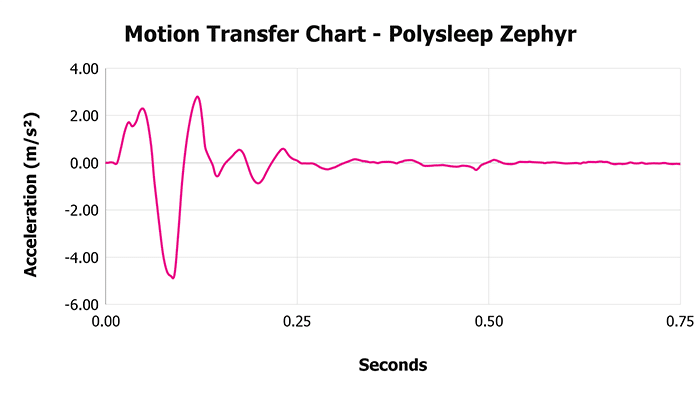
While the all-foam design isn’t doing the mattress many favors for cooling, it is absolutely a critical factor in the excellent motion transfer performance. Those who are sensitive to motion will find the performance on the Zephyr to be fantastic.
Response Test
The Polysleep Zephyr has an extremely fast response time. In our tests, we measured a mostly recovered response time of 0.2 seconds and a fully recovered response time of 0.3 seconds. This is tied for 1st with the fastest-responding mattresses we’ve tested to date.
Mostly Recovered
0.2 sec.
Complete Recovery
0.3 sec.
The level of responsiveness is documented in the video below.
The poly foams rebound back to shape effectively instantly. This rapid responsiveness ensures you’ll never feel stuck on the mattress. The foams quickly adapt to changes in movement.
Bounce Test
The Polysleep Zephyr has a low level of bounce. In our tests, we measured a total bounce height of 6.17”. This is 3.32” less bounce than the average of 9.50”.
Max. Depth
5.31″
Max. Rebound
0.86″
Total Bounce
6.17″
The low level of bounce for some sleepers will feel more jarring. This is especially true if you’ve mostly slept on coil or hybrid mattresses.
Max. Sinkage Depth
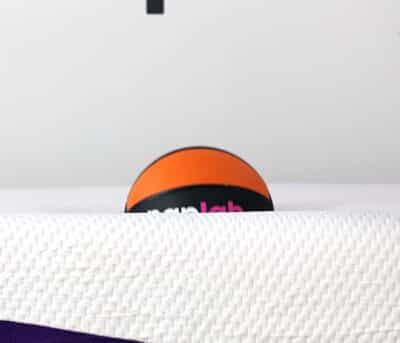
Max Bounce Height

While the limited bounce is a major factor in reducing motion transfer (which was exceptionally low), it can be problematic for sex performance (which we discuss below).
The level of bounce is also documented in the video below.
A low level of bounce can restrain ease of movement. However, the moderate level of sinkage and highly responsive feel help to maintain ease of movement, despite the lack of bounce.
Edge Support Test
The Polysleep Zephyr has good edge support for both sitting and lying. In fact, lying support was even better. In our sitting edge support tests, we measured a sitting sinkage compression of 4.0”. This is 0.05” less than the average of 4.05”.
Max. Sinkage
4.00″
Lying Support
Excellent
Reinforced Edge
Yes
The level of edge support while seated is documented in the images below.
Sitting, 140 lbs.

Sitting, 200 lbs.

Ideally, I like to see 4.0” or less and the Zephyr hit that mark. Lying edge support was equally as good. Even when lying directly on the edge of the mattress I felt well supported in all sleeping positions.
The level of edge support while lying is documented in the images below.
Lying on Edge, 140 lbs.

Lying on Edge, 200 lbs.
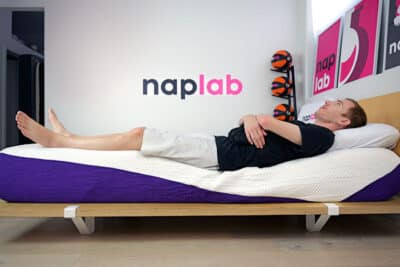
The Zephyr uses an incredibly thick 8.5” edge support foam that encases the entire perimeter of the mattress. This is unusually thick and it is absolutely a major factor in the strong edge support performance that we measured.
Sex Test
Sex performance is fair for the Polysleep Zephyr.
| Sex Factor | Factor Weight | Score | Rating |
|---|---|---|---|
| Bounce | 65% | 6.3 | Low |
| Edge Support | 20% | 8.8 | Good |
| Noise | 5% | 10 | Minimal |
| Pressure Relief | 5% | 10 | Outstanding |
| Cooling | 5% | 8.0 | Good |
This mattress has a low level of bounce, which is the factor that hurts the sex score the most, being that it accounts for 60% of the sex score.
Low bounce tends to make it more difficult to get that rhythm many partners are looking for during intimacy.

Edge support is excellent, with minimal noise, and exceptional pressure relief, but these factors alone are not really enough to save the score.
Cooling performance also saw some struggles, which could make those “hot and steamy” nights feel even hotter… and not in the way that you want.
Pressure Relief Test
The Polysleep Zephyr has outstanding pressure relief. During our tests, I felt no level of building pressure anywhere on my body. Quite to the contrary, the Zephyr is incredibly comfortable.
Comfort Layer
6.0″
Support Layer
6.0″
It has a balanced level of sinkage with a high body contouring hug. The mattress uses an unusually thick 6.0” comfort layer. This is notably thicker than the average comfort layer thickness of 4.1”.
This extra thick foam layer, in combination with better-than-average quality foams, creates fantastic comfort. Overall, I don’t really have any major complaints here. The experience is excellent.
Off-Gassing Test
Right out of the box, the Polysleep Zephyr has a strong odor. We unboxed the mattress and set it up. The odor smelled a bit like wet paint, which was fairly off-putting, but it didn’t smell for long.
Initial Smell Strength
Strong
Off-Gassing Period
3 days
Once unboxed, the mattress took 3 full days to completely off-gas. This is slightly faster than the 6-day average (across all mattresses tested to date).

Company
The company score takes a look at factors that may influence your experience with the mattress.
Factors include length of the trial period, warranty, shipping / return costs, and country of origin.
| Company Factor | Factor Weight | Score | Data |
|---|---|---|---|
| Returns | 40% | 7.0 | $90 |
| Trial Period | 30% | 8.0 | 100 nights |
| Warranty | 20% | 8.0 | 10 years |
| Shipping | 10% | 10 | $0 |
| Country of Origin | 0% | Canada |
For Polysleep, these individual terms and conditions are fair, but not great in any way.
The company offers a 100-night trial period, which is 43% shorter than the 176-night average. It also comes with a 10-year warranty.
Shipping is free to your door, but if the mattress ends up not working out, returns are C$85.
This mattress is manufactured in and shipped from Canada.
How firm is the Polysleep Zephyr?
The Polysleep Zephyr has a firmness 5 out of 10 where 10 is the most firm. This gives the mattress a medium feel, suitable for a wide range of sleepers.

A firmness of this level would be just a touch softer than a medium-firm mattress (6 out of 10). Medium-firm mattresses are the most common firmness among the mattresses we’ve tested to date.
Support & Sleeping Positions
The Polysleep Zephyr has excellent support. During our tests, I felt well-supported in all sleeping positions. The mattress checks most of the boxes that I look for.
| Support Factor | Data |
|---|---|
| Comfort Layer | 6.0″ |
| Support Layer | 6.0″ |
| Firmness | Medium |
| Body Contour | Dramatic |
| Zoned Support | Yes |
| Reinforced Edge | Yes |
We have a thick enough support layer at 6.0”, with a more than thick enough comfort layer, also at 6.0” (1.9” thicker than the average of 4.1”).

The total mattress is 12.0” thick, which is just a touch north of the average of 11.9” (based on all of our tests to date).
The general design, in combination with the high-quality foams used, creates ample support in all sleeping positions.
As with pressure relief, I don’t have any major complaints. I expect most sleepers will find the Zephyr to be perfectly supportive.
| Sleeper Weight | Stomach Sleepers | Side Sleepers | Back Sleepers |
|---|---|---|---|
| Under 150 lbs. | Yes | Yes | Yes |
| 150-250 lbs. | Yes | Yes | Yes |
| 250-300 lbs. | Yes | Yes | Yes |
Design
The Polysleep Zephyr mattress is a 12″ mattress designed as a higher-quality option compared to the Polysleep Origin and Polysleep Aura.
| Design Factor | Data |
|---|---|
| Type | Foam |
| Thickness | 12″ |
| Cover Type | Thin |
| Weight | 88 lbs. |
| Has Handles | No |
| Fiberglass-Free | Yes |
| Ships in a Box | Yes |
The thicker profile and deeper comfort layers are designed to excel in pressure relief, where other thinner mattresses may struggle.
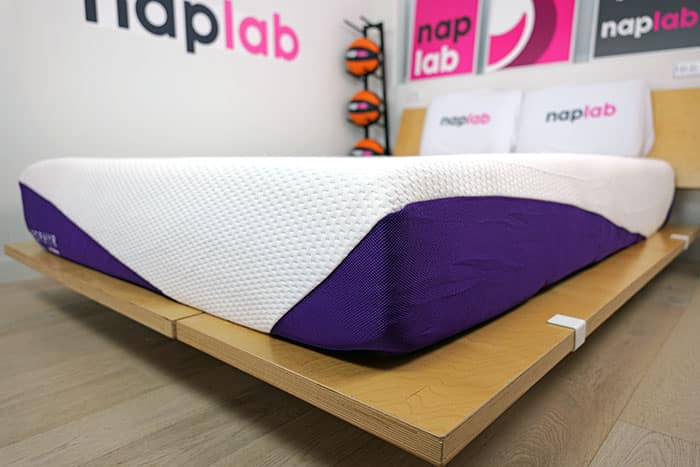
Materials
In total, the 12″ Zephyr mattress has four distinct layers from top to bottom. These layers include:
| Layer Type | Thickness | Layer Specs |
|---|---|---|
| Poly Foam | 1.0″ | 2.6 PCF |
| Poly Foam | 2.0″ | 3.0 PCF |
| Poly Foam | 3.0″ | 1.9-2.0 PCF (Center), 1.7-1.8 PCF (Head/Foot) |
| Support Foam | 6.0″ | 1.7-1.8 PCF |

The Cover
The cover of the Polysleep Zephyr is thin and breathable. It is made of 74.5% polyester, 10.5% viscose, 7% organic cotton, and 8% spandex infused with what Polysleep calls “Nanobionic technology” (unclear exactly what this material is, it sounds similar to Celliant). The Nanobionic technology, according to Polysleep, “promotes better sleep recovery”.
The 8% spandex gives the cover a nice stretch and elasticity.

The Comfort Layer
The comfort layer of the Zephyr contains three basic layers. And depending on what portion of the mattress you’re looking at, the layers may be different.
The top layer of the mattress has a 1.0″ open-cell copper poly foam with a density of 2.6 PCF. This is consistent across the entire mattress surface. This layer is also coated with a phase change material called KulKote. This coating helps to improve cooling.
Note: PCF stands for “Pounds Per Cubic Foot”. It is a measure of how much foam is actually in any given foam layer. Higher PCF foams are generally more durable.

The second layer, below the copper foam, is a 2.0″ poly foam along the entire mattress (light yellow foam in the cut-outs below). This foam has a density of 3.0 PCF so slightly denser than the top foam.
The third layer within the comfort layers varies depending on what portion of the Zephyr you’re looking at.
- At the head or foot of the mattress: 3.0″ poly foam, density of 1.8 PCF
- At the midsection of the mattress: 3.0″ poly foam, density of 2.0 PCF
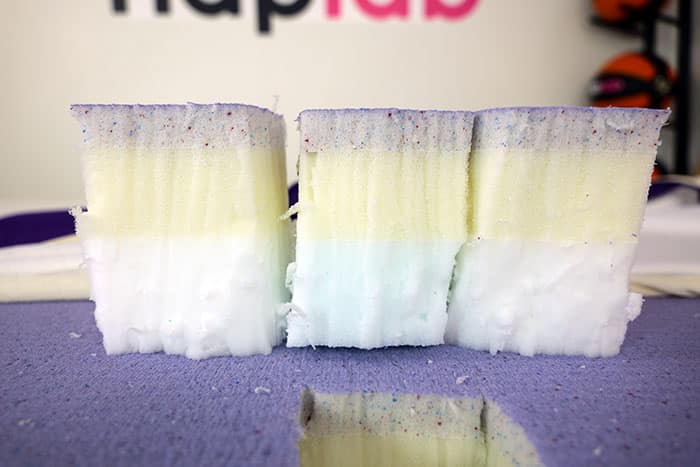
This third layer is designed for pressure relief, as it is less dense than the layers above it. As you lie on this mattress and begin to engage with these deeper layers, the variation in density helps to avoid painful pressure points.
The Support Layer
The primary support layer is a 6″ slab of support foam with a density of 1.5 PCF. This layer spans the majority of the mattress, excluding the outer edges.
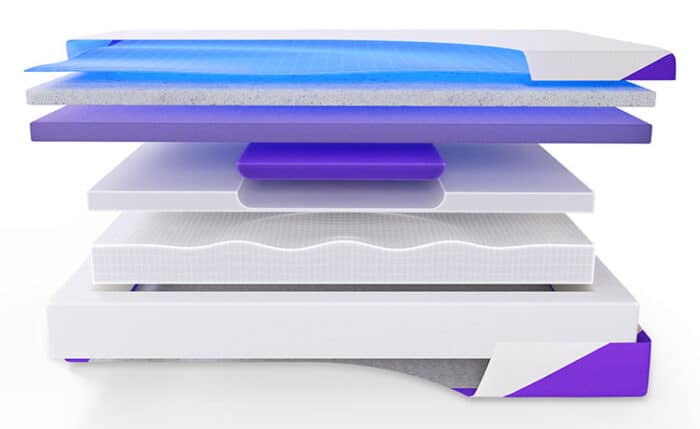
Towards the perimeter of the mattress is an 8.5″ thick edge support foam with a denser feel of 2.1 PCF.

This layer is one of the big reasons why edge support is so good on the Zephyr mattress. Whether sitting or lying on the edge, this extra thickness helps to reinforce the mattress and provide better support.
Product Evolution
The Zephyr mattress was originally launched in 2019. In April 2023, the Polysleep Zephyr mattress received an update alongside the release of the Polysleep Aura mattress.
Below are a list of the changes between the 1.0 and 2.0 version of the Polysleep Zephyr.
| Zephyr 1.0 – 2019-2022 | Zephyr 2.0 – 2023 | |
|---|---|---|
| Cover | 88% Polyester 88%, Spandex 1%, Organic Cotton 11% | 74.5% polyester, 10.5% viscose, 7% organic cotton, and 8% spandex |
| Cooling Cover | None | Kulkote cooling fibers added |
| Thickness | 11.5″ | 12.0″ |
| Support Layer | 1.8 PCF | 1.5 PCF |
Other foams, fabrics, design aspects, foam densities, and materials appear to be the same between the 1.0 and 2.0 versions.
Polysleep Zephyr vs. Polysleep Aura
Trying to decide between the Polysleep Zephyr and the Polysleep Aura? Check out this side-by-side comparison between the two mattresses.

Polysleep Zephyr
| Type: Foam |
| Thickness: 12″ |
| Firmness: Medium (5) |
| This Is It |
| Overall Score: 8.78 |
Other Mattresses to Consider
Not sure that the Polysleep Zephyr is the right pick for you? Check out these three other top-rated Canadian-based mattress alternatives you might want to consider.
For Performance
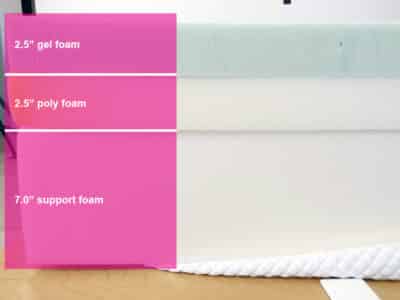
Douglas Summit
Similar Mattress Height
The Douglas Summit mattress is a 12″ thick foam mattress that uses gel foam, poly foam, and a 7.0″ support foam base. This mattress has exceptional performance across the board, a similar 12″ thickness, and a lower price tag (C$1299) compared to the Polysleep Zephyr.
For Firmness

Endy
Responsive Surface
The Endy mattress has a slightly higher performance score than the Zephyr and at a lower price point. Comparing feels, the Endy mattress is firmer than the Zephyr—6.5 out of 10 on the NapLab firmness scale. Endy is only 10″ thick compared to the Zephyr which is a 12″ thick mattress. For lighter sleepers, Endy could be a suitable alternative to the Zephyr.
For Budgets

Douglas
Lower Motion Transfer
The Douglas mattress is a 10″ foam mattress with fantastic performance all around. The Douglas outperforms the Zephyr in many performance tests, having lower levels of motion transfer and better edge support. The only real area where the Zephyr takes the win is pressure relief (thanks in part to the thicker 12″ profile). That being said, the Douglas is only C$799, saving 60% compared to the cost of the Zephyr and making it our top alternative for a budget option.
Frequently Asked Questions
Still have questions? Check out some of the top FAQs on the Polysleep Zephyr mattress below and get the answers you’re looking for.
Here are the current prices, with any sales or promotions reflected below:
Twin: C$1,716
Full: C$1,876
Queen: C$2,036
King: C$2,356
Cal. King: C$2,356
*Note: Sales prices are subject to change without notice or warning.
The original Polysleep mattress is available within the US. However, the Polysleep Zephyr, Aura, and Origin are not available within the US.
The Polysleep Zephyr comes in a single firmness of 5 out of 10, where 10 is the most firm. This gives the mattress a medium feel.




